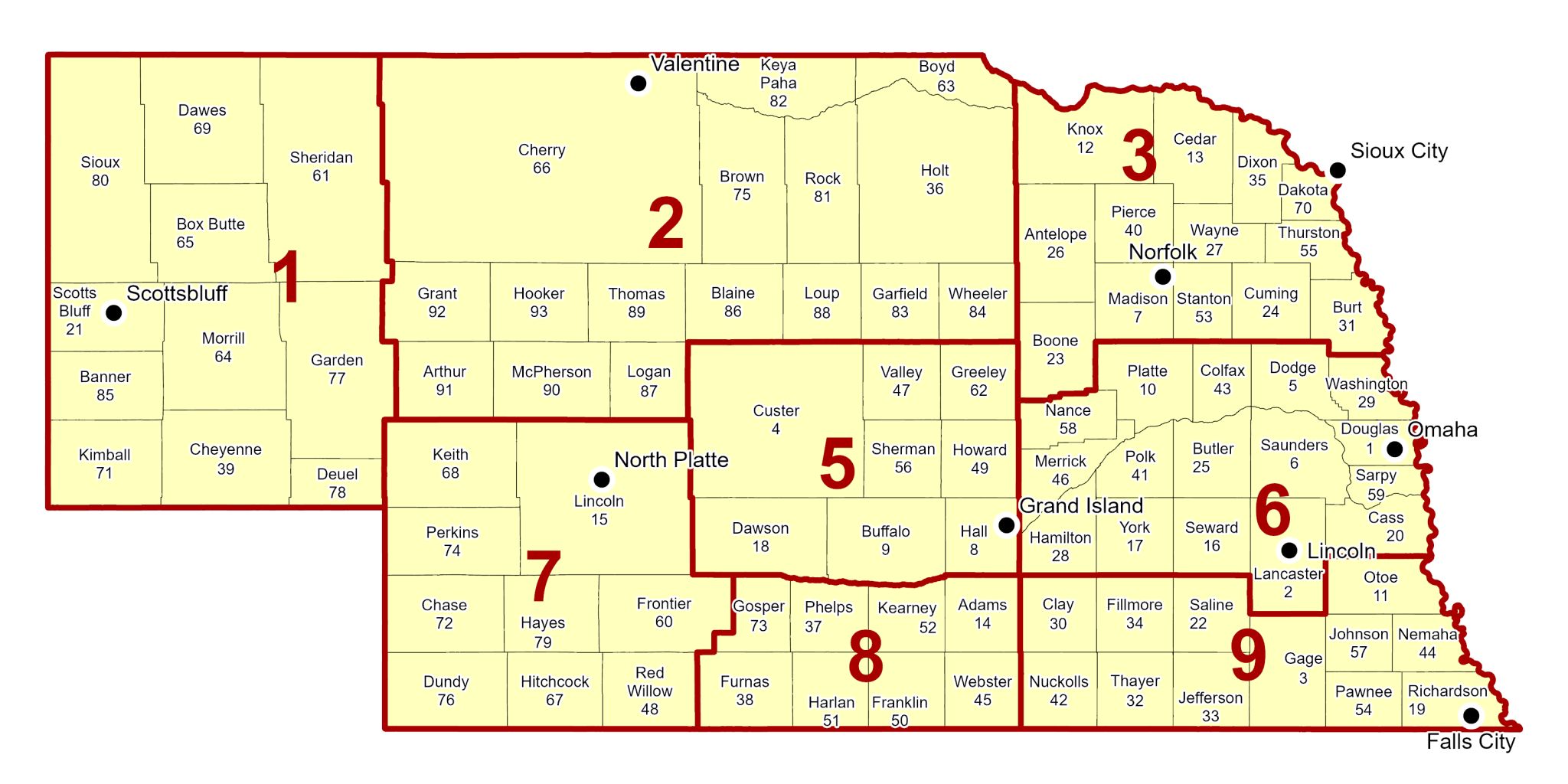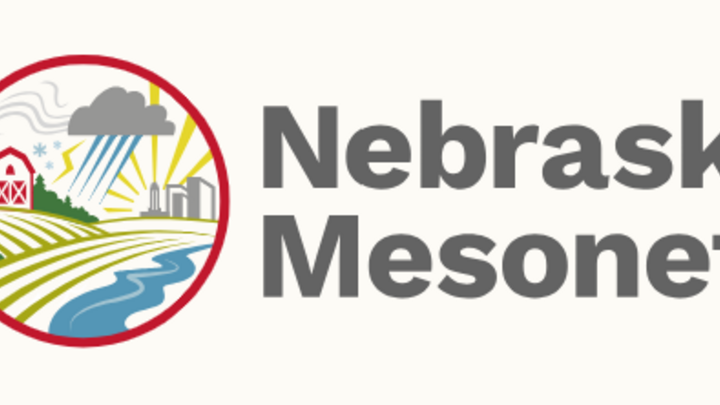Widespread stress observed
Drought is a growing problem across the state and a feature article on the latest drought conditions will be posted later in the week when the latest USDM is released. The purpose of this article is to feature what has been submitted to the Drought Mitigation Center's Condition Monitoring Observer Reports (CMOR) website to get a feel for how bad conditions may be and possible impacts. Exact locations and the name of the person(s) submitting reports have been withheld. The five reports cover the state from the Panhandle to southeast Nebraska. A map of the counties around the state is shown below.

Figure 1. County map of Nebraska. The large red, bold numbers represent the climate divisions and the small numbers are the numbering system for license plates.
Report 1:
State/Territory: Nebraska
County/Equivalent: Chase
Date: 5/13/2025
How dry or wet is it? Severely Dry
How much experience do you have with conditions there?
5-10 years
How many times in the past have you seen it like this?
Never
How localized or widespread are the conditions you are reporting?
Dundy, Chase, Perkins counties
Description and/or caption information:
Pastures are not growing and the wheat is turning brown.
Report 2:
State/Territory: Nebraska
County/Equivalent: Hitchcock
Date: 5/13/2025
How dry or wet is it? Severely Dry
How much experience do you have with conditions there?
20 or more years
How many times in the past have you seen it like this?
Twice or more
When was it most recently like this?
2022
How localized or widespread are the conditions you are reporting?
Widespread- soil moisture depleted. Rainfall at 53 percent southern Hitchcock- 10 year average. Hot dry winds
Crop conditions:
Poor - Heavy degree of loss of yield potential which can be caused by excess soil moisture, drought, disease, etc.
Planting status:
Earlier than normal
Harvest status:
Earlier than normal
Crop production:
• Less water for irrigation • Reduced yield • Plant stress • Less water in ponds, creeks, cisterns, etc.
Range conditions:
Poor - Pastures are providing marginal feed; supplemental feeding required.
Livestock production:
• Reduced pasture, forage • Feeding hay early • Supplemental feed • Purchased hay
Fire impact:
• Increased risk of fires (strong winds and dry soils)
Report 3:
State/Territory: Nebraska
County/Equivalent: Adams
Date: 5/12/2025
How dry or wet is it? Severely Dry
How much experience do you have with conditions there?
20 or more years
How many times in the past have you seen it like this?
Once
How localized or widespread are the conditions you are reporting?
Widespread in our county. We have seeds sitting in dry dirt. All pivots in the county are running to get crops to come up. But the dryland there is nothing but seeds not sprouting. We’ve had no measurable amount of rain for over a month. And before one small amount nothing. A very dry winter also. Wheat looks terrible and pastures are stressed. .
Crop conditions:
Poor - Heavy degree of loss of yield potential which can be caused by excess soil moisture, drought, disease, etc.
Planting status:
Normal
Crop production:
• Less water for irrigation • Reduced yield • Plant stress • Increased irrigation • Less water in ponds, creeks, cisterns, etc. • Other
Crop production - Other:
Seeds not able to sprout without moisture on dryland. Seeds sitting there are food for rodents etc.
Household impact:
• Other
Household impact - Other:
Between bad crop prices and more expense having to run pivots its money we wont have. For the household. The farm community is suffering after the last few years. Small farmers are taking the biggest hit.
Freshwater fish impact:
• Less water in ponds, creeks, etc. • Reduced flow in streams and rivers
Description and/or caption information:
Farmers are stressed between the low commodity prices and lack of rain. The expenses keep coming and income will be reduced. This will be after quite a few years of a major loss of income for farmers. The only way crops are coming up right now is by the use of pivots. And that just increases the expense.
Report 4:
State/Territory: Nebraska
County/Equivalent: Thayer
Date: 5/12/2025
How dry or wet is it? Severely Dry
How much experience do you have with conditions there?
20 or more years
How many times in the past have you seen it like this?
Never
How localized or widespread are the conditions you are reporting?
Might be a little localized but it's spreading fast. Areas had some minimal rain and others had nice 4 inch rain within 20 miles of each other but it's abnormally dry for this time of year
Crop conditions:
Very Poor - Extreme degree of loss to yield potential, complete or near crop failure.
Planting status:
Later than normal
Harvest status:
Earlier than normal
Crop production:
• Less water for irrigation • Reduced yield • Plant stress • Increased irrigation • Erosion • Less water in ponds, creeks, cisterns, etc.
Livestock production:
• Reduced pasture, forage • Feeding hay early • Supplemental feed • Purchased hay • More invasive species (plants) • Decreased stock weights • Animal stress • Less water in ponds, creeks, etc. • Hauled water • Sold livestock • Erosion • Other
Livestock production - Other:
hauling cattle out of state to find better grass and water
Household impact:
• Dry lawn • Cracked ground • Change in landscape design
Home and garden impact:
• Wilting on annual flowers/crops/vegetables • Leaf scorch on annual flowers/crops/vegetables • Delayed field preparation • Delayed planting time • Increased supplemental irrigation • Wilting on perennial flowers/shrubs • Leaf scorch on perennial flowers/shrubs • Stunting on new season growth • Turf turning gray/purple or curling • Dry lawn (browning in growth season) • Dusty/cracked soil
Fire impact:
• Burn or fireworks bans
Wildlife habitat impact:
• Less food for wildlife • Less water for wildlife • Increase in invasive plant or animal species • Wildlife disease or mortality • Change in animal migration • Wildlife foraging near people • Water quality reduced • Change in wetlands or swamps
Freshwater fish impact:
• Less food available for fish • Less water in ponds, creeks, etc. • Reduced flow in streams and rivers • Water quality change • Fish disease or mortality
Description and/or caption information:
Continuation of the drought over the last 3 years. Got some moisture in November but very little since. WAY behind normal for the year but when coupled with last year and the year before it's extremely below normal.
Report 5:
State/Territory: Nebraska
County/Equivalent: Kimball
Date: 5/7/2025
How dry or wet is it? Severely Dry
How much experience do you have with conditions there?
20 or more years
How many times in the past have you seen it like this?
Twice or more
When was it most recently like this?
2002
How localized or widespread are the conditions you are reporting?
100 square miles
Crop conditions:
Very Poor - Extreme degree of loss to yield potential, complete or near crop failure.
Planting status:
Normal
Harvest status:
Earlier than normal
Crop production:
• Reduced yield • Plant stress • Increased irrigation
Range conditions:
Very Poor - Pastures provide very little or no feed. Supplemental feeding is required to maintain livestock condition.
Livestock production:
• Reduced pasture, forage • Feeding hay early • Supplemental feed • More invasive species (plants) • Decreased stock weights • Animal stress
Description and/or caption information:
The pasture grass greened up shortly this spring, but is now going back dormant in the first week of May. The wheat is turning blue and is losing tillers. The mild and windy winter and spring, along with very limited precipitation has left soil with little moisture. When planting corn, the seed is going into dry dirt.


